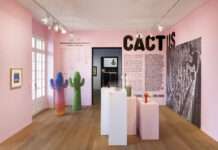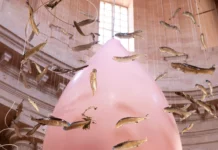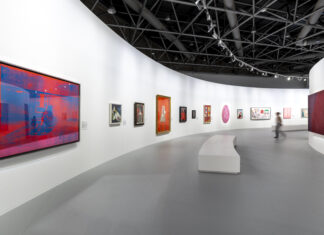Lisa Ortner-Kreil photo Johannes Siglär
Curator at the Bank Austria Kunstforum Vienna since 2013, Lisa Ortner-Kreil is at the origin of « Gerhard Richter: Landschaft » in cooperation with the Kunsthaus Zürich. « There has never been a comparable exhibition on this theme before » she explains. The exhibition was opened in Vienna on October 1st and has enjoyed immense popularity since then, even if it has to be closed until December, 6th due to necessary measures. She presents us also the contemporary art hoc projects, she founded in april 2020 during the first lockdown, together with Barbara Horvath, a specialist for art in public space, in order to bring internationally successful contemporary art to atypical places and audiences.
« Gerhard Richter: Landscape » , how this exhibition is different from previous other ones such as « Panorama » at Tate and Centre Pompidou or « Pictures/Series » at Fondation Beyeler?
Gerhard Richter’s work is extremely diverse and large, so it was clear to us from the beginning that we wanted to pick out a specific theme. The theme « Landscape » lent itself to this. Firstly, because it occupies Richter artistically throughout, from 1963 to the present day. And secondly, because there has never been a comparable exhibition on this theme before. So here it was a matter of filling a gap. The exhibition makes a retrospective claim – related to the theme « landscape » in Gerhard Richter’s work. In addition, the theme of landscape fits incredibly well, especially in the current time when we are much more aware of nature and its comforting effects than in previous years.
« Gerhard Richter: Paysage » en quoi cette exposition est-elle totalement différentes des précédentes qui ont eu lieu notamment à la Tate, au Centre Pompidou ou à la Fondation Beyeler ?
Le travail de Gerhard Richter est extrêmement vaste et varié, il était donc clair pour nous dès le début que nous voulions choisir un thème spécifique. Le thème du « Paysage » s’y prêtait tout particulièrement. Premièrement, parce que Gerhard Richter s’y est intéressé tout au long de sa carrière, de 1963 à nos jours. Et deuxièmement, parce qu’il n’y a jamais eu d’exposition comparable sur ce thème auparavant. Il s’agissait donc ici de combler une lacune et l’exposition revendique donc une approche rétrospective – liée au thème du « paysage » dans l’œuvre de Gerhard Richter. En outre, le thème du paysage résonne particulièrement bien avec les préoccupations de notre époque, beaucoup plus consciente de l’importance de la nature et de l’environnement qu’auparavant.
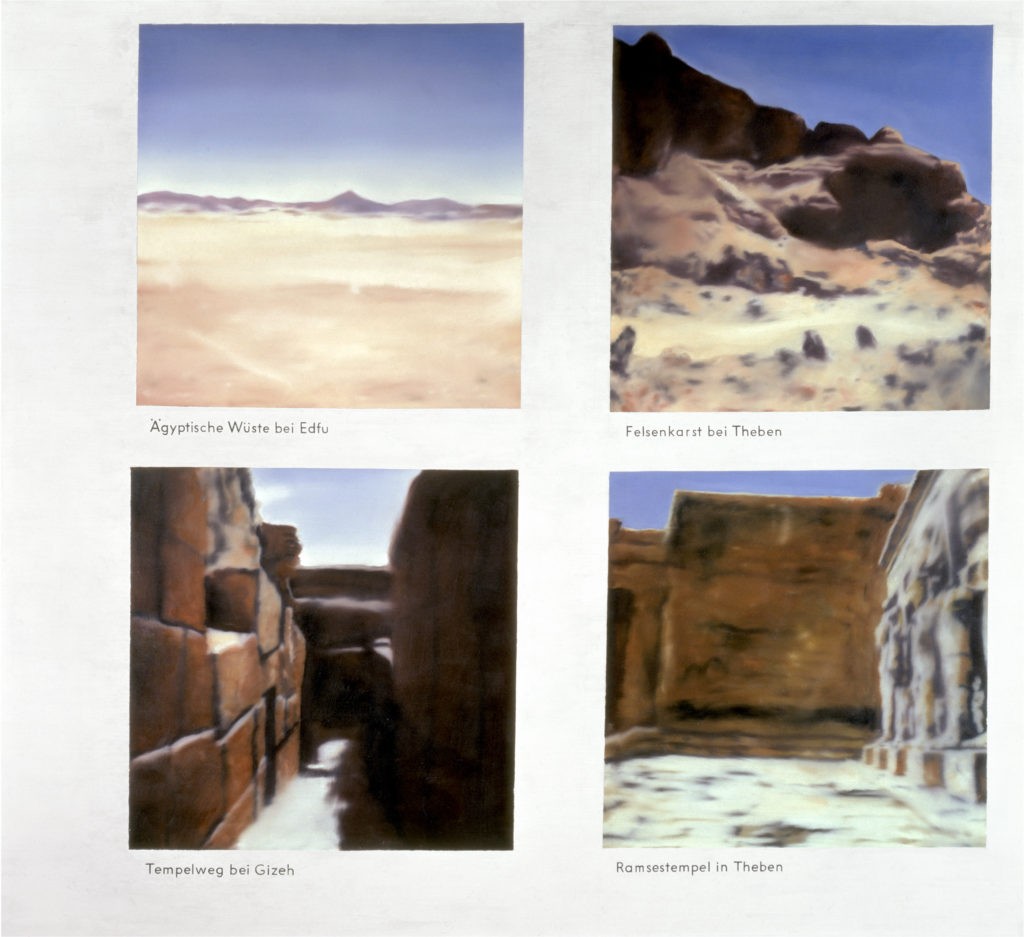
Private Collection. Courtesy Hauser & Wirth Collection Services
© Gerhard Richter
Why Gerhard Richter calls his pictures « cuckoo’s eggs » ? What does this mean to him?
Richter speaks about his romanticizing pictures, which were created from 1968 onwards, as « cuckoo’s eggs » . These pictures quote motifs or compositional principles of German Romanticism with representatives like Caspar David Friedrich. Deeply drawn horizons, atmospheric skies, the human being is left out, but on the other hand, he has left his signs, street signs, bridges, for example. Richter means with the term « cuckoo’s eggs » for these pictures that they pretend to come from another time but then there are concrete clues that we are in the 20th century. He is an artist who is of course extremely well informed about pictorial tradition and he plays with these « learned images of landscape » that we all carry within us.
Pourquoi ce que Gerhard Richer parle des ces images comme des « oeufs de coucou » quel en est le sens ?
Richter évoque ses images « romantiques », créées à partir de 1968, comme des « œufs de coucou ». Ces images citent des motifs ou des principes de composition liés au romantisme allemand tel que l’on peut en voir chez Caspar David Friedrich : horizons lointains, ciels atmosphériques, absence ou mise au second plan de l’être humain, mais simultanément, Richter y laisse ses propres signes, panneaux signalétiques de rue ou ponts, par exemple. Ce que Richter veut signifier avec le terme « œufs de coucou », c’est que ces images prétendent venir d’un autre temps tout en posant des indices concrets signifiant que nous sommes bien au XXe siècle. Il s’agit bien sûr d’un artiste qui connait extrêmement bien la tradition picturale et il joue avec ces « images savantes du paysage » que nous portons tous en nous.
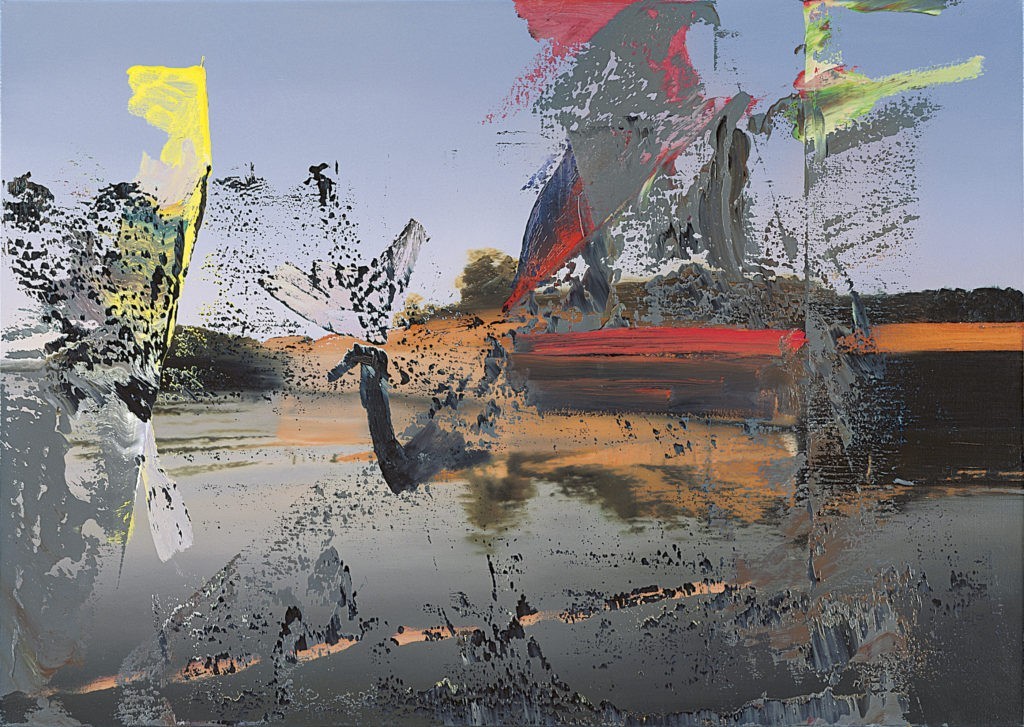
Museum Frieder Burda, Baden-Baden
© Gerhard Richter
How the European Romanticism’s legacy and the concept of the « Sublime » influenced his painting?
Richter equally appreciates and respects the role that landscape played in German Romanticism, but at the same time he points out idealizations and instrumentalizations of landscape as well. He works with blurriness or in series (like with his famous Clouds or Sceascapes pictures for example) – and thus also deconstructs the heritage of Romanticism.
Quelle est la place de l’héritage du Romantisme et du Sublime dans sa peinture ?
Richter tout en appréciant et respectant le rôle que le paysage a pu jouer dans le romantisme allemand souligne en même temps les idéalisations et les instrumentalisations liées à celui-ci. Ses œuvres ont un rendu flou ou sont exécutées en série (comme avec ses célèbres tableaux Nuages ou ses Marines par exemple) – et il déconstruit ainsi par là même l’héritage du romantisme.
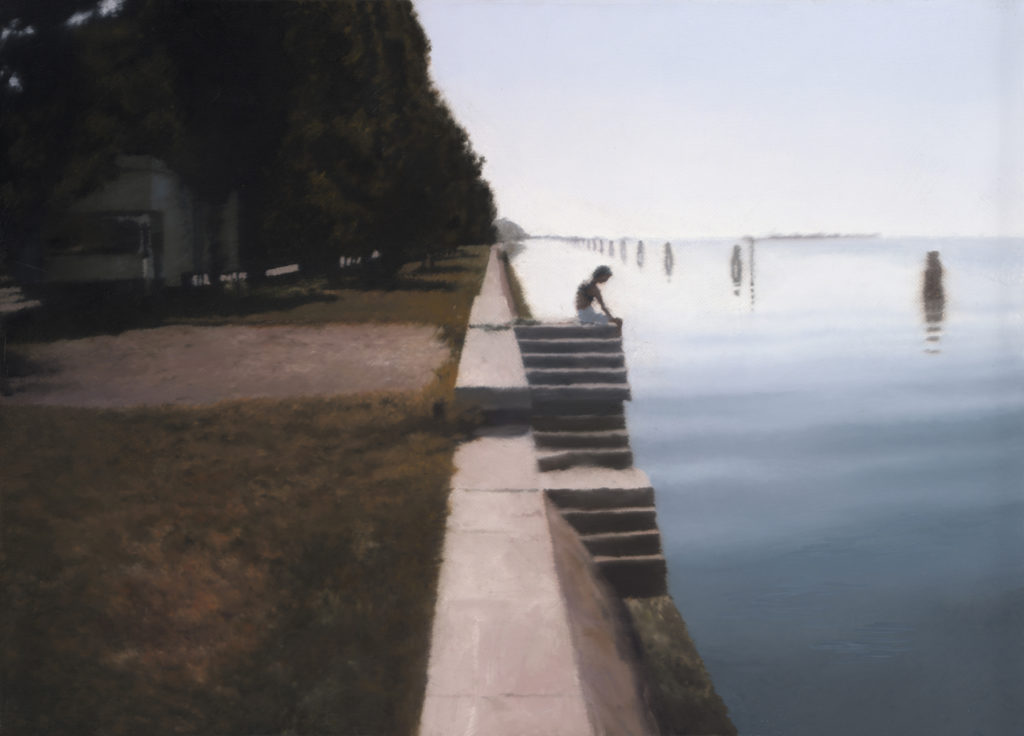
How are you facing the lockdown and the closure of the exhibition?
The exhibition was opened in Vienna on October 1st and has enjoyed immense popularity since then. We are of course very sad that we have to keep the exhibition closed until December 6th and hope that we will then be able to open it again very soon – in compliance with the necessary measures and regulations. During the lockdown, the Kunstforum tries to focus more on digital art education and programs, although we are of course aware that the digital exhibition experience cannot replace the analog visit. We concentrate on formats that offer a kind of « add on » to the exhibition visit, like our video blog « Curators Diary », in which curators discuss the work behind the exhibitions, or the art salonnière format « Viktoria Pfefferstein », where an actress welcomes visitors in a virtual salon in order to talk about current exhibitions.
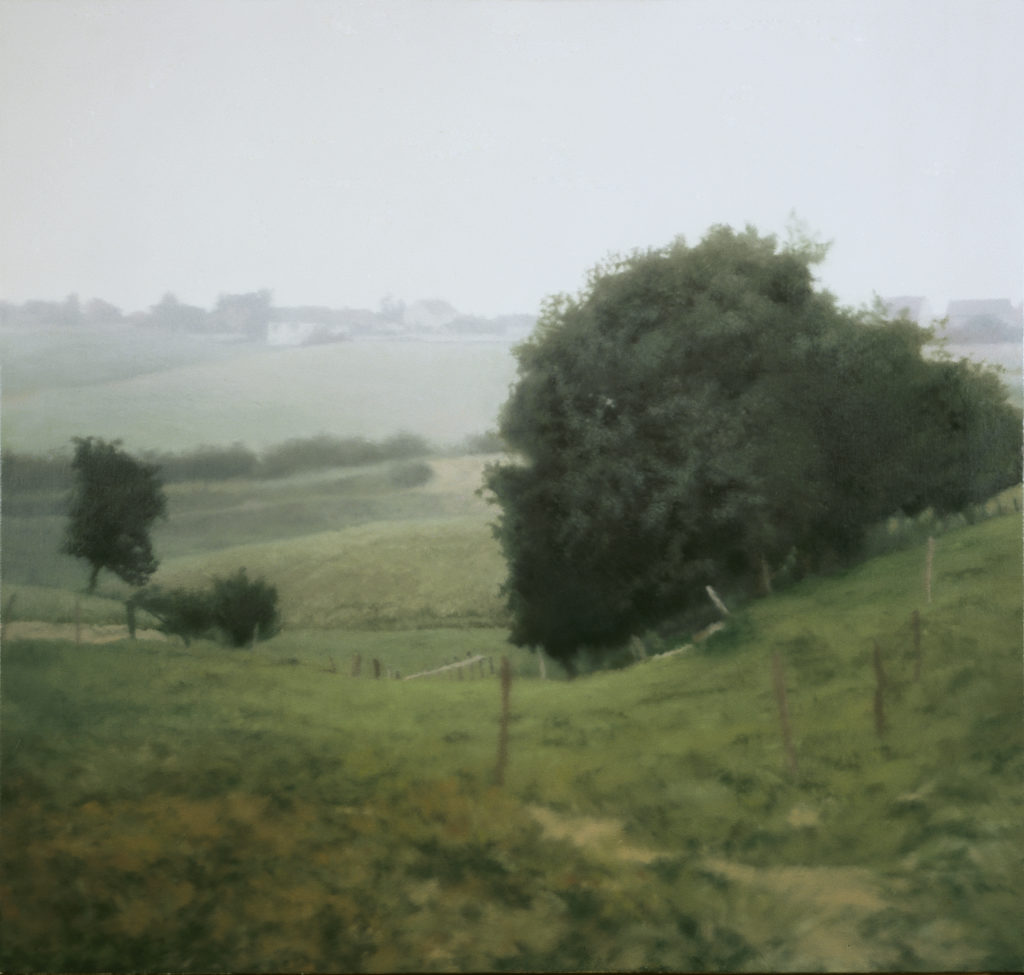
The Museum of Modern Art, New York.
Blanchette Hooker Rockefeller, Betsy Babcook, and Mrs. Elizabeth Bliss Parkinson Funds, 1985
© Gerhard Richter
Comment faites-vous face à ce nouveau confinement et quelles alternatives digitales proposez-vous ?
L’exposition a été inaugurée à Vienne le 1er octobre et jouit depuis lors d’une immense popularité. Nous sommes bien sûr très tristes de devoir maintenir l’exposition fermée jusqu’au 6 décembre et nous espérons que nous pourrons alors la rouvrir très bientôt – dans le respect des mesures et réglementations nécessaires. Pendant la fermeture, le Kunstforum essaie de se concentrer davantage sur les actions pédagogiques et les programmes d’art en ligne, bien que nous soyons bien sûr conscients que l’expérience de l’exposition virtuelle ne peut remplacer une visite « en vrai ». Nous nous concentrons sur des formats qui offrent une sorte de « complément » à la visite de l’exposition, comme notre blog vidéo « Curators’ Diary« , dans lequel les conservateurs échangent au sujet des travaux à l’origine des expositions, ou le format « Viktoria Pfefferstein« , où une actrice accueille les visiteurs dans un salon virtuel afin de discuter des expositions en cours.
Can you tell us more about the art initiative art hoc projects you found together with Barbara Horvath ?
During the first lockdown in April 2020 I founded, together with Barbara Horvath, a specialist for art in public space, the contemporary art initiative « art hoc projects », with which we try to bring internationally successful contemporary art to atypical places and audiences. A first project called IN THIS TOGETHER has just been opened in public space in St. Pölten, a city about 70 km west of Vienna. The two artists Borjana Ventzislavova and Aldo Giannotti (both born in different corners of Europe, but living and working in Vienna for many years) intervene extensively on the facades of public buildings in the city such as the town hall, the train station or the Parliament of the Lower Austrian Government on the theme « What role and what identity does Europe have in times of crisis? » IN THIS TOGETHER sends a strong signal for solidarity and cohesion in public space, which has of course been charged with a completely new meaning by Corona and the lockdown. It is, in fact, currently the only place, where you can experience art in real-life. On our website www.arthocprojects.at you can take a look at photos of the project.
Vous avez fondé avec Barbara Horvath, le programme art hoc projects lors du premier confinement : quels sont vos objectifs ?
Lors du premier confinement en avril 2020, j’ai fondé, avec Barbara Horvath, spécialiste de l’art dans l’espace public, l’initiative d’art contemporain « art hoc projects », avec laquelle nous essayons de faire connaître l’art contemporain de renommée internationale dans des lieux et vers des publics atypiques. Un premier projet intitulé IN THIS TOGETHER vient d’être inauguré dans l’espace public de St. Pölten, une ville située à environ 70 km à l’ouest de Vienne. Les deux artistes Borjana Ventzislavova et Aldo Giannotti (tous deux nés dans différents coins d’Europe, mais vivant et travaillant à Vienne depuis de nombreuses années) interviennent sur les façades des bâtiments publics de la ville tels que l’hôtel de ville, la gare ou le Parlement du gouvernement de Basse-Autriche sur le thème « Quel rôle et quelle identité l’Europe a-t-elle en temps de crise ? IN THIS TOGETHER envoie un signal fort de solidarité et de cohésion dans l’espace public, qui a bien sûr été chargé d’un sens tout à fait nouveau du fait de la Covid-19 et du confinement. C’est en effet le seul endroit, actuellement, où l’on peut faire l’expérience de l’art dans la vie réelle. Sur notre site web www.arthocprojects.at, il est possible de voir des images de ce projet.
What does this crisis inspire you?
We are all thrown back on ourselves, spending much more time at home, with our family, with ourselves. The system in which we live and work is highly developed but still incredibly fragile, and it doesn’t take much to make everything falter. I think that the « crisis » can encourage us to distinguish important from unimportant things and reorganize our priorities and I hope that we can save some of these experiences and findings into the « time after corona ». Much more respect and awareness for systemically important professions from nursing, medicine, education and childcare to food supply, for example. And a rethinking of mass events and the constant pursuit of profit maximization – we have long since reached the stage of postal growth. For museums, exhibition houses and galleries, the lockdown means above all a major push into the digital age – which the art scene was sorely in need of anyway and which would probably not otherwise have taken place at this speed of light – and a concentration on collection and archive work, an area that had often been neglected in previous years.
Quelles sont vos réflexions sur cette crise ?
Nous devons tous faire retour vers nous-mêmes, passant beaucoup plus de temps à la maison, avec notre famille, avec soi-même. Le système dans lequel nous vivons et travaillons est très développé mais reste incroyablement fragile, et il ne faut pas grand-chose pour que tout s’effondre. Je pense que la « crise » peut nous encourager à distinguer les choses importantes de celles qui ne le sont pas forcément et à réorganiser nos priorités et j’espère que nous pourrons sauvegarder certaines de ces expériences et de ces découvertes dans « le temps d’après ». Beaucoup plus de respect et de considération également pour les professions d’importance systémique, des soins infirmiers à la médecine, en passant par l’éducation et la garde d’enfants et l’approvisionnement alimentaire, par exemple. Nous devons également repenser la massification événementielle et la recherche constante de la maximisation des profits – car nous avons dépassé depuis longtemps le stade de la croissance pour la croissance. Pour les musées, les lieux d’exposition et les galeries, le confinement signifie avant tout une avancée majeure vers l’ère numérique – dont la scène artistique avait de toute façon cruellement besoin et qui n’aurait probablement pas eu lieu à un rythme si rapide – ainsi qu’une concentration sur le travail de collection et d’archivage, un domaine qui avait souvent été négligé les années précédentes.
Catalogue Gerhard Richter: Landscape edited by Lisa Ortner-Kreil, Hubertus Butin,Cathérine Hug, with contributions by Lisa Ortner-Kreil, Hubertus Butin, Cathérine Hug, Matias Faldbakken and T. J. Demos.
Hatje Cantz, Berlin, 220 pages (german and english edition)
Lisa Ortner-Kreil :
Lisa Ortner-Kreil, born in 1981, Dr. phil., studied comparative literature and art history in Vienna, Innsbruck and Rome. After working for springerin – Hefte für Gegenwartskunst, the Albertina Vienna and the Royal Belgian Museums in Brussels, she has been curator at the Bank Austria Kunstforum Vienna since 2013. In recent years she has organized highly acclaimed exhibitions, including « Eyes Wide Open – Stanley Kubrick as photographer » (2014), « XYZ – Martin Kippenberger » (2016), « Man Ray » (2018) and « Gerhard Richter: Landschaft » (2020) in cooperation with the Kunsthaus Zürich. Lisa Ortner-Kreil has developed several art education programs and event formats for the Bank Austria Kunstforum and also operates, together with Barbara Gilly, the video blog « Curator’s Diary ». In April 2020 she founded the art initiative art hoc projects together with Barbara Horvath, which aims to bring high-caliber contemporary art to atypical locations. Besides teaching at the University of Vienna and the University of Applied Arts Vienna, Lisa Ortner-Kreil regularly publishes on modern and contemporary art and is a jury member of the Bank Austria Kunstpreis Kärnten.
The Bank Austria Kunstforum :
The Bank Austria Kunstforum is the top address for art lovers, especially for classical modern painting of the post-war years. Every year, 250,000 people visit the temporary exhibitions held in this private institution, shows that are unique across the globe. Leading museums present their works here as well as private collectors. Whether van Gogh or Miró, Kandinsky or Chagall, Warhol or Lichtenstein, the great names of art are united here. Since 2000, there have also been exhibitions devoted to contemporary artists.
More about :
Gerhard Richter: Landscape
Jusqu’au 14.02.2021
Bank Austria Kunstforum is closed due to sanitary measures.

![Lisa Ortner-Kreil_(c) Johannes Siglär[2] (1)](https://fomo-vox.com/wp-content/uploads/2020/11/Lisa-Ortner-Kreil_c-Johannes-Siglär2-1-696x409.jpeg)
